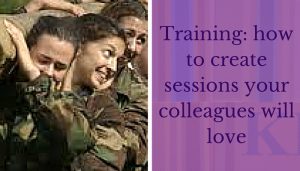If you’re tasked with running a training session, I’m guessing that the last thing you want is to be that person who sent everyone to sleep. The first time I had to deliver legal training to my former colleagues, I thought it would be easy. I had no problem being eloquent in front of a judge and they were occasionally scary. These were the people I worked with every day, yet I found myself stumbling over words, eyes glued to my notes whilst I tried to remember exactly what I was supposed to be talking to them about.
I’ve learnt that holding a good training session is all in the preparation. How you approach things depends on why your participants are there and whether they’d rather be somewhere else. If you’re telling them about something new and exciting, great. If you’re hosting compulsory training on something dull or scary or if they just need to be there to make up their CPD hours for the year, good luck!
Have a training day
I always used to love going to external training sessions, partly because it was a day out and also because it often meant a professional speaker with excellent communication skills. If you can group a series of training sessions together and arrange an away day your employees will love you and it can also take you a long way towards making sure they pay attention.
Set the tone
If you’re presenting to people that you don’t know or who don’t know each other, it’s worth starting with an ice breaker. If you’re into full on corporate bonding and want to play a game, that’s up to you. However, something simple such as going round the table and asking everyone for their name and an interesting fact about themselves can work just as well.
As a presenter, you set the tone. If you’re bored, your audience will be too and your body language speaks volumes even if you’re trying to sound upbeat. Move around the room if you can, especially if you’ve a large audience. Maintaining eye contact also helps (and no, I don’t mean choosing one person and staring at them – that’s just creepy). If you look up at your audience it helps you to spot people who are losing focus and bring them back into the conversation.
Don’t be a lone voice
Did I mean conversation? I did – if you want your session to be effective you can’t be the only person speaking. You may not know what level of knowledge your audience already has so asking them questions allows you to establish that and move onto issues that they are less familiar with. Equally, encouraging discussion gets the energy back into the room and encourages your audience to think about the topic and absorb information. This can be particularly helpful if you can break a large group down into smaller discussion groups as it means they have to move around instead of sitting in the same chair, falling asleep.
I’ve said it before and I’ll say it again – don’t just read the notes! It’s just a waste of everyone’s time. It also means that you don’t get any eye contact as everyone’s head will be down looking at a sheet of paper. Handouts with bullet points can be great as it gives your audience a structure and helps them to keep focussed. If you need to prepare a more detailed set of notes, give them out at the end.
Do you deliver training? If you have any pearls of wisdom to share, please drop a comment below!
If you want to try a new approach to your content marketing, Get in touch or register here to receive regular updates, special offers and a free copy of my guide, ’10 Tips to create copy that converts’.
